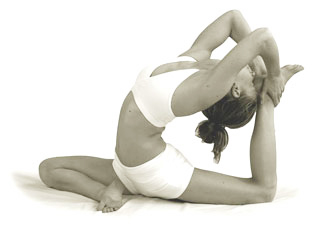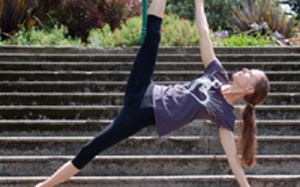
Surya Namaskara - Sun Salutations in Ashtanga Yoga
Surya Namaskara – Salutations to the Sun
Ashtanga Vinyasa Yoga begins with two forms of Sun Salutations. Surya Namaskara A and Surya Namaskara B, each type of Sun Salutation is practiced 5 times. Sun Salutations create internal heat, cultivate deep breathing and prepare the body for static asana practice.
Read Caroline‘s guide to the Sun Salutations, an article published in the Yoga Magazine and watch her guide her yoga teacher trainees through the Sun Salutations on YouTube.
Surya Namaskara, Caroline Klebl’s guide to the Salutations to the Sun
Ashtanga yoga is translated from Sanskrit as the eight steps of Union. These eight steps were defined by the Sage Patanjali over 2000 years ago in the Yoga Sutras. The eight steps are Yama (restraints), Niyama (obervances), Asana (posture), Pranayama (breath control), Pratyahara (withdrawal of the senses), Dharana (concentration), Dhyana (meditation), and
Samadhi (absorption). These combined techniques are found to be an effective method for realization of the self and ultimate liberation from suffering.
The Yamas are the moral codes, which free the mind and life of a yoga practitioner from undesirable thoughts and feelings resulting from incorrect actions. The Yamas include Ahimsa (non-violence), Satya (truthfulness), Asteya (non-theft), Brahmacharya(connected to God) and Aparighraha(non-envy).
The Niyamas are those thoughts and activities, which promote a state of mind that is conducive to yoga. The Niyamas include Saucha (cleanliness), Santosha (contentment), Tapas (heat from the practice of austerities), Svadhyaya (chanting in reference to the study of the supreme), and Ishvara Pranidhana (surrender to the supreme).
The Asana practice is the gateway into
the steps of Ashtanga Yoga. Asana practice is a tangible method of awakening and purifying the subtle energy channels in the body.

Yoga Teacher Training in Los Angeles
May 1st to 25th, 2023
For additional information and to reserve your space. Learn more
Oujaii Pranayama (a sound-induced breathing technique) activates this process. The practice of asana and pranayama clears impurities of out the body and induces a deeply meditative state. Thereby, dysfunctional behavior patterns are naturally abandoned. Therefore, the first and foremost means to attaining realization by Ashlanga yoga is to focus on the asana practice.
The Ashtanga Vinyasa Yoga System is a method of asana practice which was described in the Yoga Kurunta by Vamana Rishi. This sacred text was found by Krishnamacharya and passed onto his disciple Pattabhi Jois. The Yoga Kurunta describes a precise method of asana practice. which includes hundreds of asanas. which are divided into primary, intermediate and advanced series of postures. It is also instructed that Vinvasa is an essential element of asana practice. Vinyasa utilizes either the inhaling or exhaling breath to move the body in and out of the postures. The continuous movement between the postures, creates internal heat, which eases the body into the asanas. In the Yoga Kurunta it is mentioned to only practise asana with Vinvasa.
The Ashtanga Vinyasa method is accompanied by Oujaii Pranayama (sound-induced breath). Dristi (the looking place in the postures and Bandhas (locks or seals, involving muscular contraction at the base of the pelvis, the abdomen, and the throat).
These actions are applied in the postures and throughout the Vinyasa. The application of Vinyasa, Oujaii Pranayama, Drishti and Bandhas to Asana practice is what makes the Ashtanga Vinyasa method safe and highly effective. These principles are applied throughout the Primary, Intermediate and Advanced series of postures. Each series of postures is to be practised on a daily basis for a number of years, and then continued on a weekly basis, when a new series of postures is added.
Each series is learned by adding one posture at a time, under the guidance of an experienced practitioner and qualified teacher. Even though it seems that the Ashtanga method prescribes the same practice to everyone, by adjusting when new postures are added and the length of time each practitioner is advised to practise a series of postures, the practice is individualized. This individualization accounts for the need to strengthen unique weaknesses in each practitioner.
In order to access the depth of Ashtanga Yoga, it is instructed by Patanjali in the Yoga Sutras that practice needs to be firmly grounded, by correct cultivation over an extended, uninterrupted period of time.
Similarly the Ashtanga Vinysasa method is to be practised on a daily basis for many years, in order for the practitioner to experience the profound benefits of this practice.
The Ashtanga Vinyasa Yoga is practiced six days a week. Saturdays are the traditional rest days. The other days on which practice is suspended are on the new and full moon days and for women the first three days of menstruation. The practice is also progressively reduced during pregnancy and then suspended for up to three months after giving birth.
Before starting the practice of the asanas, which are unique to a specific series of Ashtanga Yoga, the Surya Namaskara (Salutations to the Sun) and six fundamental standing postures are practised.
“Surya Namaskara is the ultimate workship of the Sun God.” — Sri K Pattabhi Jois
Traditionally Surya Namaskara is practised facing the rising sun. This is the ideal time for asana practice, early in the morning before breakfast. If one does practise later in the day, it is best to wait 2 to 3 hours after a meal to commence yoga practice. Surya Namaskara consists primarily of Vinyasa; the only posture which is held for five breaths is Adho Mukha Shvanasana (downward-facing dog). The practice of Surya Namaskara creates heat in the body, awakens the breathing system and offers a wide range of movement to the body. In the Ashtanga Vinyasa System, there are two types of Surya Namaskara, each of which is practised five times before starting the Standing Postures. Surya Namaskara A is composed of five postures, to which two postures are added in Surya Namaskara B.
Sun Salutation A
Surya Namaskara A consists of 10 vinyasa and 7 asanas. Traditionally the vinyasa are counted in Sanskrit.
Samasitihi
The first posture of Surya Namaskara A is Samastitihi. Samastitihi means equal standing. The feet are together, the legs are straight and the arms extend down either side of the body. The spine is straight, the inhaling breath lifts the ribcage and the exhaling breath draws the navel back to the spine and contracts the muscles in the pelvic floor.
Ekam – One
To reach the first position (Ekam), on the inhaling breath, the arms are drawn up over the head until the palms of the hands touch. The head tilts back and the gaze rests on the thumbs.
Dve – Two
The second position (Dve) is Uttanasana, a standing forward bend. On the exhaling breath, the arms are stretched out to the sides and down to the floor on either side of the feet. The hips are drawn back slightly as the torso folds down over the legs. The legs remain straight, as the head is pulled in to the legs and the gaze rests at the tip of the nose.
Trini – Three
The third position (Trini) is reached
on the inhaling breath. The head is lifted until the spine and arms are straight. The eyes look up into the forehead, the sit-bones lift and the legs remain straight.
Chatvari – Four
The fourth position (Chatvari) is Chaturanga Dandasana, the four-limbed staff posture. The palms of the hands are grounded into the floor, the head remains lifted and on the exhaling breath the hips are lifted and the feet extend back until the body is straight. The elbows bend as the toes land on the floor. The elbows are eventually held directly over the wrists, bent at a 90-degree angle. The head remains lifted, with the eyes looking up into the forehead.
Pancha – Five
To enter the fifth position (Pancha) the inhaling breath pulls the ribcage forward and up as the arms straighten into Urdhva Mukha Shvanasana (upward-facing dog). As the torso moves forward between the arms and the head tilts back, one rolls forward over the toes until the toes point straight back. Only the tops of the feet and the palms of the hands press into the floor. The knees and thighs do not rest on the floor. The legs remain firmly engaged and the legs are kept straight in each asana of Surya Namaskara A.
Shat – Six
The sixth position (Shat) is Adho Mukha Shvanasana (downward-facing dog). On the exhaling breath, the hips are lifted up as the heels reach back to press into the floor and the torso is straightened, lining up with the angle of the arms. The head drops through the arms and the chin is drawn into the chest as the gaze shifts towards the navel. The fingers are spread as the palms of the hands reach out from the shoulders. The arms are parallel, shoulder width apart. The feet are hip-width apart and the toes point straight forward. This posture is held for five breaths. The breath is even and smooth. The inhaling breath equals the length of the exhaling breath. At the end of the fifth exhale, the hips are again lifted as the feet are drawn forward between the hands.
Sapta – Seven
The feet are again together when they land on the floor. On the inhaling breath, the legs, spine and arms are straightened as the gaze returns to the centre of the forehead, into the seventh position (Sapta) of Surya Namaskara A.
Ashtau – Eight
Uttanasana (standing forward bend)
is the eight position (Ashtau). The legs
remain straight as the head is pulled into the legs and one looks to the tip of the nose on the exhaling breath.
Nava – Nine
Then the head is lifted as the gaze is shifted to the centre of the forehead. The inhaling breath lifts the torso back up to standing, as the arms reach out and up into the ninth position (Nava). Here the palms press gently together, the head is tilted back and the gaze rests on the thumbs.
Dasha – Ten
Then on the exhale, the arms reach out and down to either side of the torso, the chin is dropped until it is parallel to the floor, and the gaze rests on the tip of the nose in Samastitihi.
Surya Namaskara A is repeated 5 times, before starting Surya Namaskara B.
